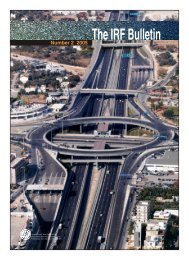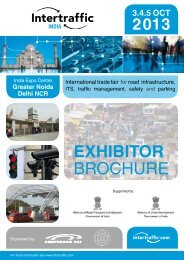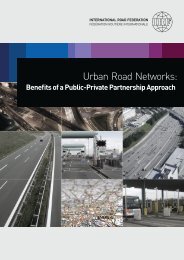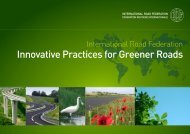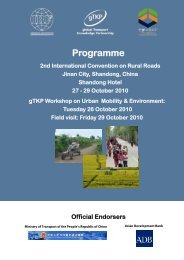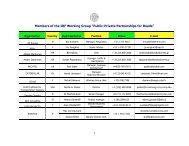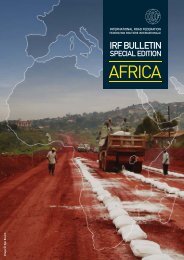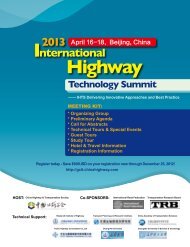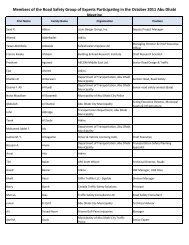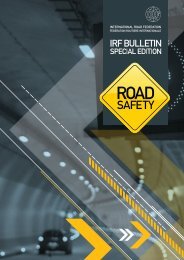TRANSPORT
TRANSPORT
TRANSPORT
- No tags were found...
Create successful ePaper yourself
Turn your PDF publications into a flip-book with our unique Google optimized e-Paper software.
MANAGEMENT<br />
MANAGEMENT<br />
Leapfrogging from Rural Hubs<br />
to New Markets<br />
Niklas Sieber<br />
Transport Economist & Regional Planner, Germany<br />
Poverty in developing countries is predominantly rural and<br />
its alleviation can be best achieved through agricultural<br />
growth. Thus, the improvement of agricultural marketing<br />
is the key to rural poverty alleviation. This requires not<br />
only well maintained roads and good transport services,<br />
but also logistical chains, telecommunications facilities<br />
and intermediate means of transport. This article, based<br />
on a World Bank paper (Sieber, 2009), shows how, with<br />
an integrated planning approach, appropriate structures<br />
may be created that improve market access for smallholder<br />
farmers and thus alleviate rural poverty.<br />
Agricultural markets in developing countries have a<br />
dualistic structure – with a ‘traditional’ sector focusing on<br />
food staples and traditional export products; and modern<br />
markets for high value foods, such as fresh fruits and<br />
horticultural and dairy produce. While the first sector is<br />
dominated by ‘traditional’ transport activities, modern<br />
markets require modern supply and logistic chains.<br />
Inefficient ‘traditional’ freight transport<br />
Presently, traditional rural freight transport is primarily<br />
related to the evacuation of agricultural produce from<br />
the fields to domestic and international markets. The<br />
first mile is conducted on local paths and tracks, mainly<br />
by headloading, which is the most expensive means of<br />
transport (Sieber, 1999). Inefficiencies currently dominate<br />
rural transport operations in many developing countries,<br />
especially in Sub-Saharan Africa: Bad roads, low quality<br />
and unreliable services, monopolistic transport markets<br />
and high charges are the most important problems.<br />
Since bad market access hampers development, rural<br />
roads generate strong impacts on agricultural production<br />
and marketing, and thus contribute to poverty alleviation.<br />
However, roads are not enough due to their rather<br />
permissive character, so transport services and modes have<br />
to be taken into account as well. Intermediate Means of<br />
Transport (IMT) can reduce transport costs significantly,<br />
if multimodal transport chains are used. While IMT can<br />
efficiently carry small quantities on local infrastructures,<br />
trucks operate cost efficiently over longer distances,<br />
on good roads and when fully loaded. The multimodal<br />
approach uses the comparative advantages of each<br />
mode in the transport chain from the field to the market<br />
(Sieber, 1998). Thus, the promotion of IMT for multimodal<br />
transport is an essential component for the improvement<br />
of rural freight transport.<br />
New opportunities through emerging agricultural<br />
markets<br />
Flowers from Kenya, cherry tomatoes from Senegal, green<br />
beans from Niger, organic cucumbers from China are<br />
offered more and more in the supermarkets of industrialised<br />
countries. A tremendous growth in world food trade has<br />
been observed over the past decade. Exports of horticulture,<br />
livestock, fish, cut flowers and organic products now make<br />
up 47% of all developing country exports; far more than<br />
the 21% for traditional tropical products such as coffee,<br />
tea and cotton.<br />
Additionally, in many developing countries, a rapid rise<br />
in the number of supermarkets since the 1980s has<br />
determined the structure and logistics of agricultural<br />
markets. In Latin America, supermarkets are buying 2.5<br />
times more fruits and vegetables from local producers than<br />
all the exports of produce from the region to the rest of<br />
the World. Future agricultural markets in middle-income<br />
countries will be dominated by supermarkets; while in<br />
poorer countries they are still in their infancy.<br />
The new markets create diversified opportunities for<br />
developing countries, not only to supply high-value<br />
produce, but also to carry out value-adding processes<br />
such as washing, pre-packing, mixing, labelling and bar<br />
coding. Consequently, many new economic activities<br />
may be undertaken within developing countries; thus<br />
increasing the rural value added dimension. For example,<br />
in Bangladesh, when exporting French beans, more value<br />
is added through transport, handling and packaging than<br />
by the original farming activities. The new paradigm that<br />
emerged from such developments on the world market<br />
was that, if producers were more closely linked to their<br />
20<br />
| IRF BULLETIN SPECIAL EDITION: RURAL <strong>TRANSPORT</strong>, VOLUME-2



